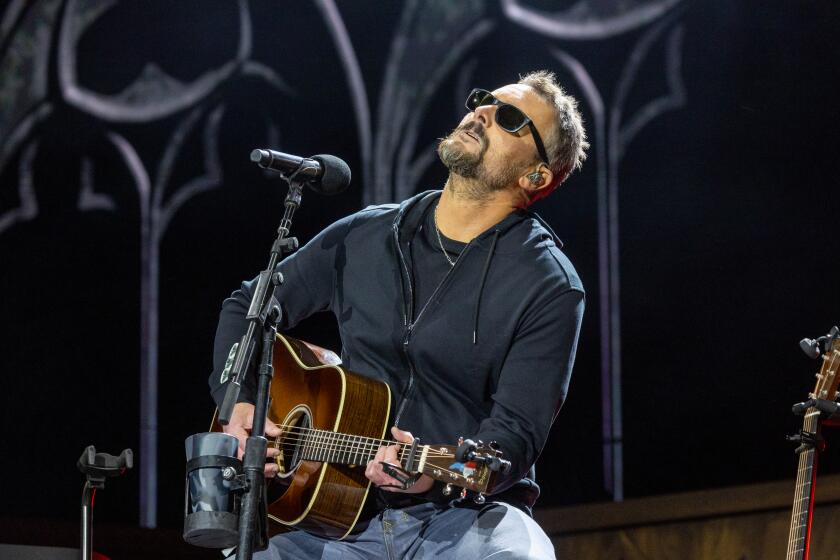Montoya’s Farewell Tour Arrives in Irvine Tonight
The only satisfying definitions of flamenco are existential: hear it, see it, live it, do it. Aficionados can’t even agree on an etymology for the word, let alone what it might properly describe.
For a generation of Americans, the definitive flamenco experience came courtesy of Carlos Montoya. He has toured a solo guitar recital--the same one, some critics might say--for more than 40 years, with almost annual visits to Southern California, playing everywhere from the posh-est concert halls to campuses to amusement parks.
Now Montoya is here again, with concerts tonight at the South Coast Community Church for UC Irvine and Saturday at Caltech in Pasadena. This time around may be his last, however. It is billed as the farewell tour for the guitarist, who is just two months shy of 86.
Although he often toured elsewhere, Montoya is largely an American phenomenon. His enduring career here has often seemed built on showmanship and hype as much as musicianship, which paradoxically has left his real achievements undervalued in some quarters.
Carlos Garcia Montoya was born in Madrid, Dec. 13, 1903, a Gypsy on all four sides, as just about any biographical reference reminds us. He began playing the guitar when he was 8, having learned from his mother. Her brother happened to be the great Ramon Montoya Salazar, the true fountainhead of solo flamenco guitar.
His early musical career was spent in the cafes, accompanying singers and dancers in traditional cuadros flamencos, while he worked as a government clerk and served a stint in the Spanish army.
After he left the service, Montoya joined the troupes of some flamenco legends: Antonia Merce (La Argentina), Vicente Escudero, and later Encarnacion Lopez (La Argentinita), with whom he performed until she died in 1945.
Montoya was touring abroad during the Spanish Civil War and was in the United States when World War II began. He married an American in 1940, later became a U.S. citizen and has since lived mainly in New York, although self-deprecating references to his poor English remained a part of his routine.
It was after La Argentinita died that Montoya launched a solo career. That was a novelty--a flamenco guitarist leaving behind the sheltering fold of the cuadro and traditional accompaniment duties.
It was not unheard of, however, although the Montoya mythology would have it that he was the first to give solo flamenco recitals (a claim still advanced in the UCI calendar). That honor, however, in fact goes to his uncle, Ramon Montoya, roughly 20 years earlier. By the mid-1930s, Ramon Montoya was already making solo recordings in Paris.
Carlos Montoya also claims to be the most widely recorded flamenco guitarist ever. That could be true, though difficult to prove one way or the other, and a distinction that says as much about marketing as it does about artistry.
The puffery is needless, for in this country at least, Montoya was indeed a pioneer, a tireless apostle to the indifferent and the ignorant. He established a way for the flamenco guitar, against long odds, that has since been profitably followed by many.
Partly as a concession to his audience, no doubt, but also as a product of his creative, exploratory energies, Montoya included flamenco versions of American popular and jazz standards. Back when fusion was a term more for physicists than musicians, before Paco de Lucia turned the traditional flamenco world upside down or the Gipsy Kings were even born, Montoya was playing “St. Louis Blues,” “Blues in the Night,” and his own versions of Spanish classical pieces.
He also worked often with symphony orchestras, although he claims never to have learned how to read music. With the help of Julio Esteban, he composed a “Suite Flamenca,” which he premiered with the St. Louis Symphony in 1966.
In the traditional flamenco forms, Montoya often sticks to stereotyped formulas, loudly amplified and coarsely played. Virtuosity in flamenco should increase musical tension and power, but Montoya is likely to drop an interminable left-hand trill or an unsteady tremolo variation in anywhere, beaming broadly at the audience while overplaying shamelessly.
But when his slumbering duende --the personal demon of inspiration of the old Gypsies--awakes, Montoya can be magically compelling in sudden flights of improvisatory imagination. He is a showman, yes, skillfully stroking his audience, but he is an artist as well.
This is not the end of an era. The musical great-grandchildren of Montoya’s generation are already on the stage, and flamenco--however much it may distress the purer-than-thou traditionalists--is a living, changing art.
But this is the apparent passing of a unique and seminal musical personality, one who single-handedly did much to create an audience for flamenco in this country.
Que vaya bien. Carlos Montoya will perform at 8 tonight at the South Coast Community Church, 5120 Bonita Canyon Road, Irvine. Tickets: $5 to $12. Information: (714) 856-5000.
More to Read
The biggest entertainment stories
Get our big stories about Hollywood, film, television, music, arts, culture and more right in your inbox as soon as they publish.
You may occasionally receive promotional content from the Los Angeles Times.






